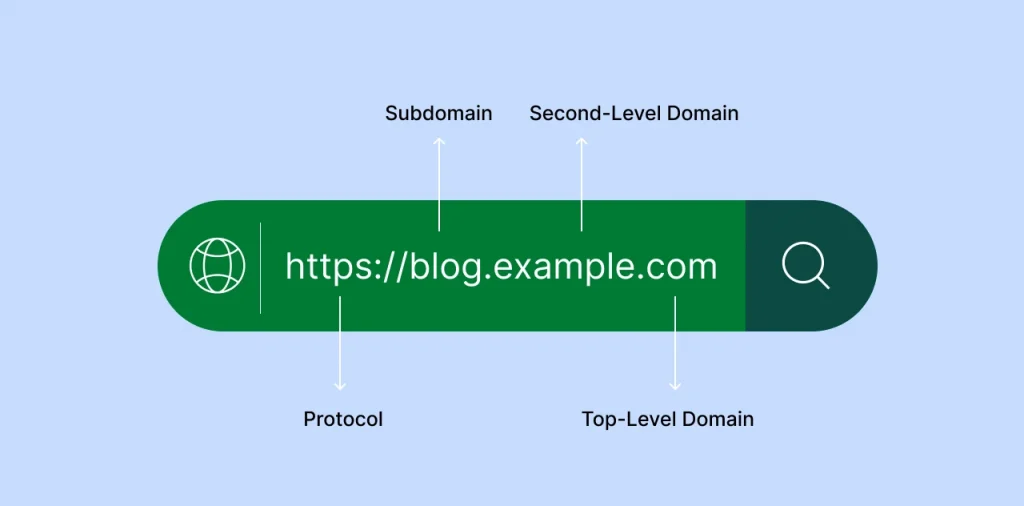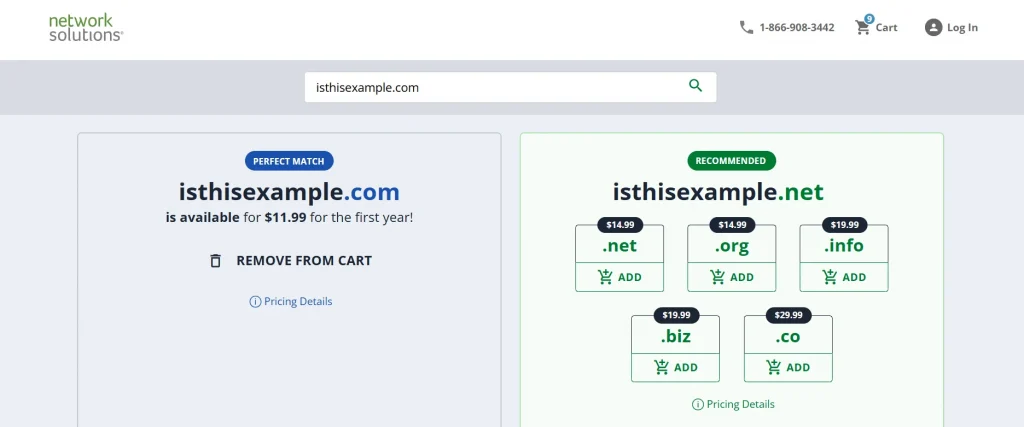Key takeaways:
- Domain names are made up of top-level domains, second level domains, and sometimes, a subdomain.
- The .com domain extension is one of the most popular gTLDs since the 80s.
- Generic top-level domains have an indirect impact on a site’s SEO.
Choosing between .com, .org, or .net when setting up your website can be confusing, but it’s a necessary decision to make. Those endings are called generic top-level domains (gTLDs), and they go beyond being your website’s address; they guide how people perceive your site.
In this article, we will discuss gTLDs and why choosing the right one can make all the difference.
Domain names and the Domain Name System
To understand gTLDs, it’s important to learn what domain names are first and how they work on the Internet.
A few key pieces make up a domain name:
- The second-level domain
- The top-level domain or the extension
- The subdomain

Second-level domain
A second-level domain (SLD) is the part of a domain name that comes directly before the top-level domain in a web address. For instance, in “example.com,” “example” is the second-level domain, representing the unique identifier or name of the website.
Top-level domain
A website’s top-level domain, or TLD, further distinguishes websites from one another and helps identify their content. In “example.com,” the .com is the TLD. Although .com is the most popular, it can have varieties like .org, .net, .us and more.
Subdomain
Subdomains are specific tags you add to your main domain name to point to a different area of your site, without needing a whole new web address. For instance, if your website is “example.com,” creating a subdomain like “blog.example.com” helps you set up a separate space for your blog, keeping everything neat and organized under the same primary name.
So how does a domain name and all its parts work on the internet?
The Domain Name System (DNS) translates human-friendly domain names into IP addresses that computers use to identify each other on the network. When you type a web address into your browser, DNS helps direct your request to the right server.
- Your browser sends a query to a DNS server to find the IP address for the domain name.
- If the DNS server doesn’t have the information, it checks other servers, including:
- Root servers. They point to the TLD servers.
- TLD servers. These servers help direct the request to the correct authoritative DNS server, based on the last part of the domain name.
- Authoritative servers. These servers hold the final information about the domain and its corresponding IP address.
- TLDs and SLDs help DNS pinpoint the exact domain you’re looking for. DNS first checks the TLD servers to find where to direct the request. Then, it looks for the specific SLD to locate the authoritative server for that domain. If a subdomain is specified, DNS directs the request to a particular section of the site, such as a blog or store, by finding the corresponding IP.
- Once the correct IP address is found, it’s sent back to your device.
- Your browser uses the IP address to load the website.
- The IP address may be stored in your server’s DNS cache for quicker access to future requests.
This process makes the internet much more user-friendly, saving you from having to memorize long IP addresses.
What is a gTLD?
A generic top-level domain (gTLD) is a kind of domain extension that isn’t tied to any specific country, which sets it apart from country-specific suffixes like .uk or .us. These global extensions can affect how people see your website, and they give you lots of options to choose from. You can pick one that fits your brand’s personality or the purpose of your business.
Knowing the different types of gTLDs can help you choose a domain extension that gets your site noticed and resonates with the people you’re trying to reach.
There are a few generic TLD categories:
- Generic TLDs
- Sponsored TLDs
- Generic restricted TLDs
- New gTLDs
- Infrastructure gTLD
Generic gTLDs
Generic gTLDs are the ones you know best and use the most. They’re the .com, .org, and .net type, available to anyone worldwide, no matter where you’re from or what you do. With these domains, you can have a solid and flexible online presence that stands out.
Sponsored TLDs
Sponsored top-level domains are created for specific communities, industries, or interest groups. Organizations control these extensions and establish and monitor eligibility requirements for their use. For instance, .edu is specifically for educational institutions, while .gov is used exclusively by government bodies.
Generic restricted TLDs
Generic restricted gTLDs strike a balance between generic and more restricted options. They’re like generic gTLDs but come with some extra rules. Take the .biz extension, for instance. Its intended use is for genuine business purposes, so only actual businesses can use it.
New gTLDs
As the internet grow, so does the demand for specific type of websites. Internet Corporation for Assigned Names and Numbers (ICANN), the global internet community that manages TLDs, announced a new gTLD program to expand domain options for brand owners and organizations.
Infrastructure TLDs
The infrastructure TLD category, made up of just .arpa, plays a crucial role in the behind-the-scenes workings of the Internet. This category isn’t open to registration by the public; it’s meant to keep the Internet’s underlying systems running smoothly.
All gTLDs are run by either their sponsoring organization or by a registry operator approved by ICANN. This setup helps to keep the internet running smoothly.
How to choose a gTLD?
In choosing the right gTLD, consider the following:
- Your audience. If you’re targeting a general audience, use familiar and trusted gTLDs. If you’re targeting a specific audience, use an industry-specific gTLD.
- Your industry. Pick a gTLD that fits your niche.
- Your brand. Make sure your gTLD aligns with your business name and branding.
The bottom line is that your gTLD tells potential visitors what your site is about. So, it’s important that your chosen gTLD reflects your purpose and credibility.
gTLDs vs ccTLDs
Choosing the perfect domain extension for your website depends on knowing the difference between the two main types: generic top-level domains and country code top-level domains (ccTLDs). If you want to reach a global audience, .com, .org, and .net are good choices.
On the other hand, if your focus is on a particular country, country code domains like .uk, .de, or .ca can be a great choice. These immediately let visitors know where you’re based, which is perfect for businesses that want to appeal to local customers or tap into regional markets. This can help your site show up higher in local search results. So, whether you’re going for an international appeal or a local vibe, your domain name can make a big difference.
Here are other examples of ccTLDs:
- .au – Australia
- .ca – Canada
- .cn – China
- .br – Brazil
- .eu – European Union
- .fr – France
- .nl – Netherlands
- .ru – Russia
- .us – United States of America
Compared to gTLDs, ccTLDs help websites target internet users in their geographic region. Many ccTLD domain name owners believe that using a specialized ccTLD gives them a competitive advantage. Some ccTLDs, like .ca or .us, have geographic restrictions on who can register and use them.
What are the benefits of gTLDs?
Since its introduction in the 80s, gTLDs have served generations of internet users with benefits like:
- Familiarity
- Trust-building
- Specificity
In fact, even the first wave of gTLDs still remains popular up to this day. Let’s go over popular gTLDs and see their benefits.
.com
The .com gTLD, which stands for commercial, has remained popular ever since the first wave of gTLDs was released. Originally intended for use by for-profit, commercial businesses, .com became the go-to extension for most websites, making it the most popular and common for internet users.
This familiarity leads to an implicit authority possessed by .com websites. People tend to trust .com websites as they see them all the time.
.net
The net in .net stands for network. This suggests that the .net gTLD is intended for tech-based companies and industries. It’s frequently used for websites advertising, promoting, and selling web-based services.
.org
.org is another gTLD that anyone can register for. Since it means organization, its original purpose was to indicate that a website belongs to a nonprofit organization. Like .net and .com, .org is among the oldest and most credible gTLDs.
Websites with .org gTLD are usually trustworthy. Some of the most famous .orgs, like Wikipedia, have done a lot to improve the credibility of this classic gTLD. The .org gTLD is often associated with websites that offer reliable information and is commonly used to register websites that serve as an online home for communities of people with similar interests.
While it’s intended for nonprofits, it’s not limited to them. So, if you’re considering getting a .org, secure it now.
.edu
While this TLD was initially broadly associated with education, its registration has been limited primarily to accredited educational institutions in the United States over time. This is mainly due to the management of the .edu TLD by Educause, a U.S.-based organization, under the authorization of the U.S. Department of Commerce. Other countries often use different TLDs for educational institutions, such as .ac.uk in the United Kingdom or .edu.au in Australia, which aligns more closely with their own naming conventions.
.gov
This TLD is specifically for federal, state, and local government entities. The management and allocation of .gov domains are handled by the U.S. General Services Administration (GSA), following strict guidelines that restrict use to official U.S. government organizations. Other countries typically use country-specific TLDs for their government entities, such as .gov.uk for the United Kingdom or .gc.ca for Canada.
.mil
The .mil TLD is for the United States military. Managed by the U.S. Department of Defense, it provides a secure domain space for U.S. military communications and operations. Other nations use different systems for their military establishments, often incorporating their country code within the TLD.
You’ve likely seen or recognized most, if not all, of these gTLDs. Because of their recognition, it’s easy to gain trust from your target audience.
Want to learn more about other TLDs? Check out our list of domain extensions.
Do gTLDs affect SEO?
No, gTLD doesn’t affect search engine optimization (SEO). But it can have an indirect impact.
For example, you choose a well-known generic domain extension like .com or .org. The audience’s familiarity with these gTLDs prompts them to trust or click on a website with these gTLDs attached to it.
If they immediately explain what your website is about, like how a .biz extension indicates your site’s involvement in eCommerce or online business, visitors are also more likely to click on your website compared to websites with vague domains. More clicks means more traffic, and search engines see this as a sign of your site’s relevance, improving your rank on the results page.
How to register a domain name with your chosen gTLD
The best way to register a domain name is through an accredited domain registrar, like Network Solutions. To register a domain name at Network Solutions, follow these simple steps.
- Go to the domain name search tool and type your desired domain name.

- When your desired domain name is available and is in your cart, click Continue. We also automatically add Domain Privacy + Protection to protect your domain. You can uncheck it depending on your preferences.
- You’ll land on our Domain Package page. Select your desired package and click Continue.
- You can now choose your domain add-ons like Domain Expiration Protection and Google Workspace. Then click Add to Cart.
- Once you’ve finalized your domain add-ons, click Continue to Cart.
- Review your cart and click Continue to Checkout.
- Fill in all necessary information and click Submit Payment.
Tip: If you need more domain name ideas, use our AI Domain Name Generator.
Make your mark online with a gTLD today
It’s clear that gTLDs influence how people perceive and use your website. From the versatile .com to the community-driven .org, choosing the right one can boost your website’s visibility and credibility. Moreover, mastering the basics of the DNS and understanding the different parts of a domain name gives you the power to make more informed choices to keep your site relevant and connected with your audience.
Do you already have a specific gTLD for your domain in mind? Register it now with Network Solutions and don’t miss on valuable domain products like Domain Privacy + Protection and Domain Expiration Protection.
Frequently asked questions
The term top-level domain (TLD) refers to its position at the very top of the Internet’s Domain Name System (DNS) hierarchy. Think of the DNS like a family tree of website names, and TLDs are right at the top, after the last dot in a web address. This structure helps keep the Internet organized by categorizing domain names into easily manageable groups.
Because certain gTLDs and ccTLDs are more popular than others, prices between them tend to vary. Prices may also vary depending on the domain registrar. For Network Solutions, we offer $11.99 for a .com on the first year.
Choosing a suitable TLD for your website boils down to what you’re all about and who you’re talking to. If you’re setting up a business aiming for a global reach, .com might be the way to go. But if you’re a nonprofit, .org could better reflect your identity. Think about how your choice might resonate with your audience and what it says about your website.
gTLDs can make your brand stronger and easier to remember and type. It can also make your site look more legit, especially if you go with something like .edu or .gov, which have a lot of authority.
.com is the most popular TLD out there. It’s what businesses around the world turn to first.
ICANN is responsible for overseeing and setting standards for top-level domain extensions.




